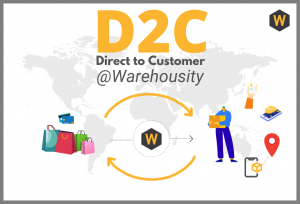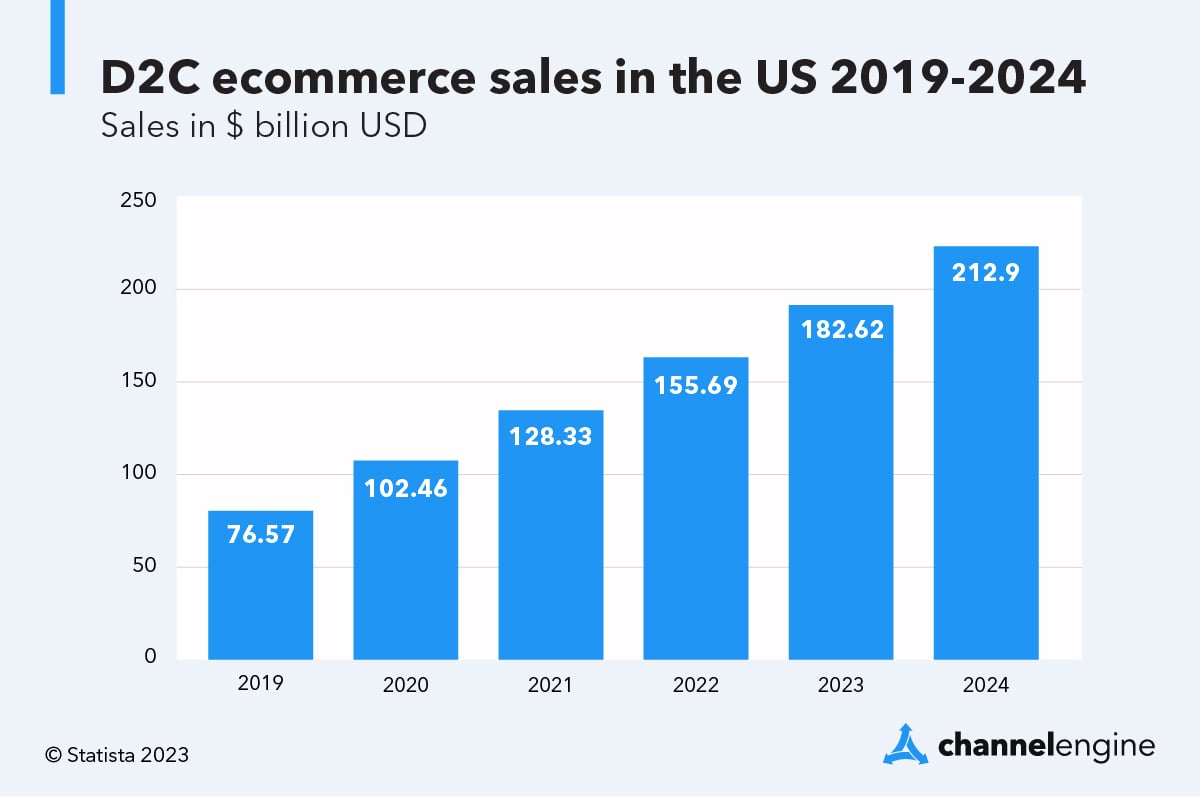Exploring the Prospective of D2C Ecommerce: A Comprehensive Overview for Businesses
The D2C ecommerce version provides a substantial shift in just how brands engage with consumers. It enables business to bypass traditional retail channels, promoting much deeper links and possibly enhanced earnings margins. This method is not without its complexities. Recognizing the nuances of D2C ecommerce is essential for brand names aiming to grow. What techniques can they adopt to browse this developing landscape properly? The answers may redefine their company approaches.
Recognizing the D2C Ecommerce Design

Trick Perks of D2C Ecommerce for Brands
The D2C ecommerce design uses brands substantial benefits, particularly concerning increased earnings margins. By eliminating intermediaries, companies can preserve a bigger share of sales income. Additionally, this direct connection with consumers promotes boosted brand name commitment, encouraging repeat acquisitions and long-term involvement.
Enhanced Profit Margins

Improved Brand Name Commitment
Structure on the economic advantages of D2C ecommerce, boosted brand loyalty becomes an additional crucial benefit for firms involving straight with consumers. By developing a direct connection, brand names can foster much deeper relationships with their customers, acquiring insights right into actions and preferences. This direct communication enables more individualized marketing approaches, which reverberate highly with consumers. Additionally, brands have the opportunity to regulate their messaging and consumer experience, strengthening brand name values and constructing trust fund. When customers really feel an individual connection, they are a lot more most likely to return, promote for the brand, and take part in area interaction. Eventually, enhanced brand name commitment not just drives repeat purchases however additionally cultivates an enthusiastic customer base, additional strengthening a brand's placement on the market.
Obstacles Dealt With by D2C Brands
D2C brand names run into numerous substantial obstacles that can affect their success. Supply monitoring problems can lead to stock scarcities or excess, complicating operations and consumer fulfillment. Additionally, advertising budget plan constraints typically limit the capability to successfully involve and reach target market.
Stock Administration Issues
Effective stock monitoring offers an awesome challenge for numerous brand names operating in the direct-to-consumer (D2C) area. These brand names commonly grapple with fluctuating demand, which can bring about overstock or stockouts, inevitably impacting consumer satisfaction and profits. Furthermore, the lack of advanced supply tracking systems can cause inconsistencies in between real stock degrees and reported data, making complex order gratification. The diverse range of products D2C brand names generally use also makes complex supply administration, as variations in designs, dimensions, and colors require even more meticulous oversight. Several D2C businesses might have a hard time with minimal warehousing abilities, leading to ineffective use of room and sources. Consequently, reliable stock administration stays a vital hurdle for D2C brands aiming for sustainable growth and operational efficiency.
Advertising And Marketing Budget Constraints
Steering advertising budget plan restraints is a significant challenge for lots of direct-to-consumer (D2C) brand names. Restricted economic resources typically limit these companies' ability to purchase all-encompassing advertising approaches, leading to minimized presence in an affordable market. D2C brand names frequently grapple with the need to maximize roi (ROI) while targeting details audiences efficiently. This challenge is exacerbated by increasing costs in electronic marketing and the need to assign funds throughout numerous channels, including social media sites, search engines, and e-mail marketing. Subsequently, lots of D2C brands have to innovate affordable advertising remedies, leveraging organic growth methods and influencer collaborations. Eventually, successfully navigating these budget restrictions is crucial for maintaining development and achieving long-term productivity in the developing ecommerce landscape.
Strategies for Developing an Effective D2C Ecommerce Organization
As consumers progressively seek direct links with brands, establishing a successful D2C ecommerce business calls for a strategic approach that focuses on client interaction and trust. One effective method is to produce engaging brand name stories that resonate view website with target audiences, promoting emotional links. Making use of social networks platforms can improve presence and promote two-way communication, allowing brand names to engage directly with customers.Moreover, personalized experiences with tailored advertising and marketing initiatives can greatly improve customer retention and commitment. Carrying out commitment programs and using exclusive offers can additionally incentivize repeat purchases.Streamlining the buying process is crucial, making certain an user-friendly user interface that enhances the shopping experience. In addition, clear communication relating to shipping and returns constructs trust fund and motivates consumer confidence.Finally, actively looking for client responses and replying to it demonstrates a commitment to renovation and consumer contentment, vital elements in the competitive D2C landscape.
Leveraging Technology for Improved Customer Experience
In today's competitive D2C ecommerce landscape, innovation plays a critical role fit customer experiences. Companies increasingly utilize sophisticated tools such as expert system, chatbots, and customized formulas to improve interactions and simplify the shopping process. By integrating these modern technologies, brand names can supply customized product referrals based on private preferences and purchasing habits, promoting an extra interesting experience.Moreover, responsive internet site styles and mobile applications guarantee that clients can access solutions effortlessly across different tools. Enhanced repayment services, including one-click checkouts and digital budgets, better simplify transactions, making it simpler for customers to make purchases.Data analytics also allows companies to collect insights right into customer actions, permitting constant renovation of solutions and offerings. On the whole, leveraging modern technology not only improves client satisfaction yet additionally cultivates loyalty, ultimately driving long-lasting success in the D2C ecommerce a fantastic read market.
Marketing Tips to Drive D2C Sales
Exactly how can brand names efficiently capture the focus of consumers in a saturated market? To thrive in the direct-to-consumer (D2C) landscape, brand names need to use targeted marketing techniques. Using social media sites platforms, brands can involve customers through interactive content, influencer partnerships, and user-generated blog posts. Customized email projects can likewise foster a feeling of link, using customized promos based on consumer habits and preferences.Moreover, storytelling plays an essential duty in differentiating a brand name's story, making it unforgettable and relatable. Brand names need to invest in search engine optimization (SEO) to boost presence, guaranteeing their items are quickly discoverable online. In addition, leveraging data analytics enables organizations to refine their advertising strategies and understand consumer patterns better. Inevitably, a multi-channel method that combines creative thinking with data-driven understandings can considerably boost D2C sales, permitting brands to stand apart in a jampacked industry.
Future Fads in D2C Ecommerce
With the rapid evolution of modern technology and customer preferences, the future of D2C ecommerce is positioned for substantial change. Emerging trends indicate a change towards hyper-personalization, where brands leverage information analytics to tailor offerings to individual consumer needs. This modification boosts customer experiences, fostering loyalty and engagement.Moreover, sustainability is ending up being a vital variable, with consumers increasingly preferring brands that focus on green methods - D2C Ecommerce Agency. Companies are anticipated to take on transparent supply chains and lasting materials to meet this demand.The integration of learn the facts here now expert system and augmented truth will furthermore change the buying experience, allowing consumers to imagine items in their environments before acquisition. Furthermore, social commerce is expected to grow, as platforms like Instagram and TikTok promote smooth purchasing experiences straight within social media.These fads jointly represent a dynamic future for D2C ecommerce, stressing customer-centric techniques and innovative innovations that redefine customer interactions
Regularly Asked Questions
What Industries Benefit The Majority Of From D2C Ecommerce?
The existing concern highlights industries that grow via direct-to-consumer (D2C) ecommerce. Extremely, fashion, appeal, electronic devices, and food fields utilize D2C versions to raise brand name commitment, boost client relationships, and maximize earnings margins properly.
Exactly How Do Delivering Expenses Impact D2C Prices Strategies?
Shipping costs significantly affect D2C prices techniques. Businesses must balance these costs with affordable pricing, thinking about consumer expectations and earnings margins. Reliable management of delivery can improve customer contentment and drive sales in direct-to-consumer versions.
What Repayment Alternatives Should D2C Services Deal?
D2C services should use diverse repayment choices, consisting of credit/debit cards, digital budgets, and buy currently, pay later services. This range enhances client ease, boosts conversion prices, and deals with various customer choices in the on the internet purchasing landscape.
Exactly How Can D2C Brands Handle Client Returns Effectively?
D2C brand names can deal with consumer returns effectively by carrying out user-friendly return plans, supplying prepaid shipping labels, and making sure punctual refunds (D2C Ecommerce Agency). Clear communication and structured procedures enhance client satisfaction and motivate repeat organization
What Legal Considerations Exist for D2C Ecommerce Workflow?
Legal considerations for D2C ecommerce procedures include conformity with consumer security legislations, information privacy laws, copyright rights, and taxation demands. Brands should browse these intricacies to avoid lawful mistakes and ensure smooth procedures. By eliminating middlemans, D2C brands can provide competitive prices and cultivate an extra intimate relationship with their customers.The D2C model is identified by its dependence on electronic systems, allowing brands to utilize social media, on-line markets, and their very own websites to involve with customers directly. D2C ecommerce promotes the collection of important consumer data, enabling brand names to customize their offerings and advertising techniques properly, inevitably driving sales and increasing margins. Additionally, brand names have the chance to control their messaging and customer experience, reinforcing brand worths and developing depend on. As consumers progressively look for direct connections with brands, developing an effective D2C ecommerce organization requires a critical strategy that focuses on client involvement and depend on. D2C brand names can take care of client returns efficiently by implementing user-friendly return policies, using prepaid delivery labels, and making certain timely reimbursements.